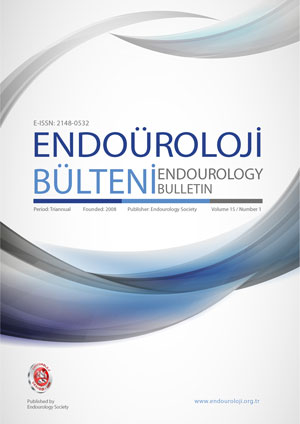
Editorial Board Message
Prof.Dr. R. Gökhan ATIŞ
Editorial Borad
Arbitrators List
Contents
Original Article
In Vivo Evaluation of the Chemical Composition of Urinary Stones Using Non-
Contrast Helical Computerized Tomography
Osman Raif Karabacak, Fatih Sandıkçı, Hakan Saltas, Alper Dilli, Kürşad Zengin, Fatih Yalçınkaya, Ümit Yaşar Ayaz
Abstract
Objective: To determine the density and chemical structure of renal stones by using in vivo low dose helical computerized tomography (CT).
Material and Methods: 79 patients with urinary stones such as renal or uretheral stones were included in our study who were going to have extracorporeal shock wave lithotripsy (ESWL) or planned to go through urinary stone surgery due to renal stones. All stone densities were measured in Hounsfield Unit by low dose abdominal non-contrast helical computed tomography examination. Marconi MX 8000 CT system with 4 detectors was used for the CT examination. X-Ray diffractometry was used in the analyses of all stones.
Results: The stone type was found to be pure type in 52 patients, and mixed stone in 27 patients. The largest group among the mixed stones included whewellite stone with 17 patients. Uric acid stones had the smallest, whewellite stones had the highest density. The difference between the density values of uric acid and cystine stones and the other stone types were statistically significant.
Conclusion: Non-contrast helical computed tomography used in the diagnosis can also be used in the in vivo determination of the stone composition. It can be very helpful to define stone compositions by imaging studies to provide suitable therapeutic alternatives.
Keywords: stone, density, tomography, helical, hounsfield unit
Original Article
The Influence of Pain and Anxiety on the Pain Perception and Outcome of Extracorporeal Shockwave Lithotripsy
Nihat Türkmen, Cemil Kutsal
Abstract
Objective: In this study, we aimed to investigate the effect of depression and anxiety presented before
extracorporeal shockwave lithotripsy (ESWL) on pain perception during ESWL.
Material and Methods: A total of 60 kidney stone patients who underwent ESWL between October 2019 and November 2020 were enrolled in the study. Patients’ age, sex, body mass index (BMI), and stone parameters were recorded. The patient’s anxiety and depression states were evaluated using the Hospital Anxiety and Depression Scale (HADS) before the first session. The pain level was assessed by using the visual analog scale (VAS) after the first session.
Results: There was no statistically significant difference between the anxiety, depression, and VAS scores (p>0.05). The association between anxiety and depression scores and the procedure’s success was also evaluated, and no significant association was found (p>0.05). Furthermore, there was no association between VAS score and patient’s age, sex, BMI, the distance from skin to stone, and stone size (p>0.05).
Conclusion: Our results do not show a significant correlation between pre-ESWL depression or anxiety
with the VAS score measured after the procedure.
Keywords: anxiety, extracorporeal shockwave lithotripsy, pain perception, urinary stone disease
Original Article
Intraoperative Assessment of Stone Free Status for Percutaneous Nephrolithotomy Surgery: Surgeon’s Eye
Mehmet Yiğit Yalçın, Batuhan Ergani, Taha Çetin, Mustafa Karabıçak, Mert Hamza Özbilen, Çağdaş Bildirici, Erkin Karaca, Mehmet Yoldaş, Erdem Kısa, Tufan Süelözgen, Gökhan Koç, Özgür Çakmak, Hayal Boyacıoğlu, Yusuf Özlem İlbey
Abstract
Objective: In patients who underwent percutaneous nephrolithotomy (PNL),it was aimed to determine the accuracy of the surgeon’s intraoperative stone-free status (SFS) prediction, the factors affecting it, the predictors that cause incorrect estimation, and finally to evaluate the reliability of the “surgeon’s eye”.
Material and Methods: The data of 1025 patients who underwent PNL and met the inclusion criteria were evaluated retrospectively. Since the basis of our study was based on the evaluation of the surgeon’s stone-free prediction, patients identified as “absence of residual stone fragment (RF)” by the surgeon were grouped and compared with postoperative computed tomography imaging according to the presence of RF.
Results: Sensitivity, specificity, positive predictive value and negative predictive value were calculated as 67.87%, 96.23%, 91.67% and 83.04%, respectively. In our study, it was found that the “surgeon’s eye” predicted SFS incorrectly at a rate of 16.9%. There was no statistically significant relationship between gender,-stone side,stone density and hemoglobin decrease between the two groups. Stone size,operation time, fluoroscopy time, location of the stone,number of stones in the calyces and GUY’s stone score (GSS) were found to be statistically significant in relation to the “surgeon’s eye”. As a result of multivariate logistic regression analysis stone size, number of stones in the calyces and GSS were significant predictors of the parameters that had a statistically significant relationship with the surgeon’s eye.
Conclusion: The most important determinants of “surgeon’s eye” in PNL were stone size,number of stones in the calyces and GSS. These predictors can be used as an effective criterion in the use of methods to reduce radiation exposure in postoperative imaging of patients who are predicted to be stone-free.
Keywords: kidney stones, percutaneous nephrolithotomy, stone-free status, intraoperative evaluation, surgeon’s eye
Original Article
Comparison of Open Radical Cystectomy vs Robot-Assisted Radical Cystectomy Perioperative Outcomes and Complications at a Single Center. An Analysis of Matched Pairs
Harun Özdemir, Emin Taha Keskin, Merve Şam Özdemir, Metin Savun, Halil Lütfi Canat, Abdülmüttalip Şimşek
Abstract
Objective: The standard curative treatment for non-metastatic high-risk non-muscle-invasive and muscle- invasive bladder cancer is regional pelvic lymphadenectomy (PLND) combined with radical cystectomy. The most prefered surgical procedure is an open radical cystectomy (ORC). However, there are significant risks related to this surgical procedure. Robot-assisted radical cystectomy (RARC), one of the minimally invasive surgical procedures, has been demonstrated to reduce surgical morbidity and boost recovery. In this study, we examined the postoperative complications and outcomes of patients who underwent RARC and ORC for bladder cancer in our clinic using matched pair analysis.
Material and Methods: Between January 2021 and February 2023, datas of radical cystectomy patients
were collected retrospectivelly at our clinic. Twenty patients who underwent RARC and forty patients who underwent ORC were matched at a ratio of 1:2 for age (± 2 years), gender, clinical TNM stage, and urinary diversion (ileal conduit or orthotopic neobladder) during the same period. The outcomes and complications of perioperative and postoperative procedures have been compared.
Results: There was no difference in preoperative data between the two groups. The RARC group had found significantly longer operative times (307.5 versus 391.7 minutes; P=0.001). Patients with RARC group had significantly lower bood-loss (P=0.001) and required less intraoperative blood transfusions (P=0.023). ICU stays were significantly longer in ORC (p =.047). The rates of mild Clavien complications were found to be similar between groups in the postoperative first 90 days. Open surgery was found to be associated with a significantly higher incidence of major (clavien 3-5) complications (p =.042). The 90-day mortality rates for RARC and ORC were found to be 0% and 7.5%, respectively. There was no difference in pathological outcomes between the two groups.
Conclusion: Our initial experience with RARC has demonstrated its safety and practicability, with comparable pathology outcomes, reduction of perioperative blood loss, and advances in 90-day mortality, when compared to ORCs with more years of experience.
Keywords: bladder cancer, complication, robot-assisted radical cystectomy
Original Article
The Effects of Pelvimetric Measurements on the Operation Time of Open Retropubic Radical Prostatectomy
Mustafa Aydın, Lokman İrkılata, Mustafa Koray Kırdağ, Uğur Öztürk, Mehmet Özen, Emrah Küçük, Hakan Yıldız, Reha Ordulu, Mustafa Kemal Atilla
Abstract
Objective: To investigate the effect of pelvimetric measurements on the operative time of patients who
underwent open radical retropubic prostatectomy for prostate cancer.
Material and Methods: Sixty patients who underwent open radical retropubic prostatectomy between
2014 and 2022 and who seradiological images were accessed were included in the study. Demographic characteristics, pathology reports and surgery notes of the patients were recorded. Preoperative X-rays, pelvic magnetic resonance and computed tomography images of the patients were examined. Inter-antero superior iliac spine distance (IASISD), Transverse pelvic brim distance (TPBD), Inter tuberous distance (ITD), Anteroposterior pelvic brim distance (APBD), Pubic height (PH), Superior pubis to mid-tuberous point (SPMP) and Infrapubic angle (IA) measurements were made.The effects of the measurements on the operationtime were evaluated.
Results: The mean age of the patients was 63.21±15.12, and the mean body massindex was 25.95±5.45.The mean prostate volume of the patients was 52.15±21.2 mL, prostate specific antigen (PSA) was 20.48±5.34 ng/ml, and the operation time was 137.36±30.2 minutes. 24 (40%) patients had a Gleasonscore of 7 and above, 20 (33%) patients had digital rectal examination findings and 18 (30%) patients were in pT3 stage. When the effect of pelvimetric measurements on the operation time was examined, no correlation was found between the measurements and the operation time.
Conclusion: The anatomical features of the patients may have an effect on the open radical retropubic
prostatectomy operation, but as a result of our study, we did not find any effect of pelvimetric measurements on the operation time.
Keywords: prostate cancer, radical prostatectomy, pelvimetric measurements


